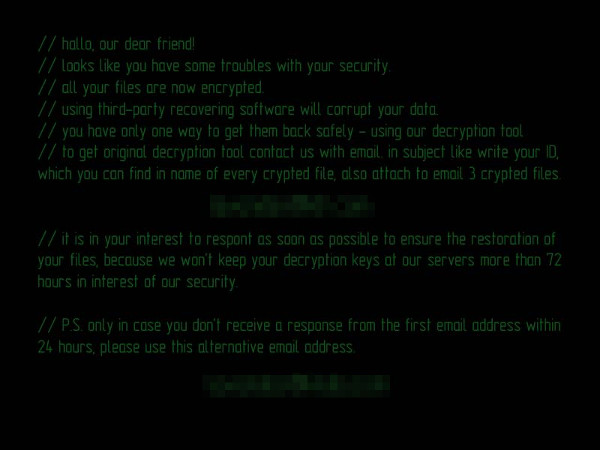RANSOM_CRYSIS.F116KT
Windows


Threat Type: Trojan
Destructiveness: No
Encrypted: Yes
In the wild: Yes
OVERVIEW
Downloaded from the Internet, Dropped by other malware
This Trojan arrives on a system as a file dropped by other malware or as a file downloaded unknowingly by users when visiting malicious sites.
TECHNICAL DETAILS
375,296 bytes
EXE
Yes
28 Nov 2016
Encrypts files, renames files, Drops files
Arrival Details
This Trojan arrives on a system as a file dropped by other malware or as a file downloaded unknowingly by users when visiting malicious sites.
Installation
This Trojan drops the following files:
- Ransom Notes:
- %Desktop%\Hallo our dear friend.txt
- %User Startup%\Hallo our dear friend.txt
- %User Startup%\Hallo our dear friend.jpg
- %User Profile%\Hallo our dear friend.jpg
(Note: %Desktop% is the desktop folder, where it usually is C:\Documents and Settings\{user name}\Desktop in Windows 2000, Windows Server 2003, and Windows XP (32- and 64-bit); C:\Users\{user name}\Desktop in Windows Vista (32- and 64-bit), Windows 7 (32- and 64-bit), Windows 8 (32- and 64-bit), Windows 8.1 (32- and 64-bit), Windows Server 2008, and Windows Server 2012.. %User Startup% is the current user's Startup folder, which is usually C:\Documents and Settings\{user}\Start Menu\Programs\Startup on Windows 2000 and XP, and C:\Documents and Settings\{User name}\Start Menu\Programs\Startup on Windows Vista, 7, and 8.. %User Profile% is the current user's profile folder, which is usually C:\Documents and Settings\{user name} on Windows 2000, XP, and Server 2003, or C:\Users\{user name} on Windows Vista and 7.)
It drops the following copies of itself into the affected system:
- %System%\{malware filename}
(Note: %System% is the Windows system folder, where it usually is C:\Windows\System32 on all Windows operating system versions.)
Autostart Technique
This Trojan adds the following registry entries to enable its automatic execution at every system startup:
HKEY_LOCAL_MACHINE\SOFTWARE\Microsoft\
Windows\CurrentVersion\Run
{malware filename} = "%System%\{malware filename}"
It enables its automatic execution at every system startup by dropping the following copies of itself into the Windows Common Startup folder:
- %User Startup%\{malware filename}
(Note: %User Startup% is the current user's Startup folder, which is usually C:\Documents and Settings\{user}\Start Menu\Programs\Startup on Windows 2000 and XP, and C:\Documents and Settings\{User name}\Start Menu\Programs\Startup on Windows Vista, 7, and 8.)
Other System Modifications
This Trojan sets the system's desktop wallpaper to the following image:
- %User Profile%\Hallo our dear friend.jpg
(Note: %User Profile% is the current user's profile folder, which is usually C:\Documents and Settings\{user name} on Windows 2000, XP, and Server 2003, or C:\Users\{user name} on Windows Vista and 7.)
Other Details
This Trojan encrypts files with the following extensions:
- .3GP
- .7Z
- .APK
- .ASM
- .AVI
- .BMP
- .C
- .CAL
- .CASB
- .CCP
- .CDR
- .CER
- .CHM
- .CKP
- .CMX
- .CONF
- .CPP
- .CR2
- .CS
- .CSS
- .CSV
- .DACPAC
- .DAT
- .DB
- .DB3
- .DBF
- .DBX
- .DCX
- .DJVU
- .DOC
- .DOCM
- .DOCX
- .DRW
- .DWG
- .DXF
- .EPUB
- .FB2
- .FLV
- .GIF
- .GZ
- .IBOOKS
- .ISO
- .JAVA
- .JPEG
- .JPG
- .JS
- .KEY
- .MD2
- .MDB
- .MDF
- .MHT
- .MHTM
- .MKV
- .MOBI
- .MOV
- .MP3
- .MP4
- .MPEG
- .MPG
- .MRG
- .PDB
- .PHP
- .PICT
- .PKG
- .PNG
- .PPS
- .PPSX
- .PPT
- .PPTX
- .PSD
- .PSD
- .PSP
- .PY
- .RAR
- .RB
- .RBW
- .RTF
- .SAV
- .SCR
- .SQL
- .SQLITE
- .SQLITE3
- .SQLITEDB
- .SWF
- .TBL
- .TIF
- .TIFF
- .TORRENT
- .TXT
- .VSD
- .WMV
- .XLS
- .XLSX
- .XML
- .XPS
- .ZIP
It renames encrypted files using the following names:
- {host filename}.[la{blocked}@dr.com].wallet
NOTES:
The ransom note contains the following information:

The malware changes the affected system's wallpaper to the following image:

SOLUTION
9.800
12.928.07
29 Nov 2016
12.929.00
30 Nov 2016
Step 1
Before doing any scans, Windows XP, Windows Vista, and Windows 7 users must disable System Restore to allow full scanning of their computers.
Step 2
Note that not all files, folders, and registry keys and entries are installed on your computer during this malware's/spyware's/grayware's execution. This may be due to incomplete installation or other operating system conditions. If you do not find the same files/folders/registry information, please proceed to the next step.
Step 3
Identify and terminate files detected as RANSOM_CRYSIS.F116KT
- Windows Task Manager may not display all running processes. In this case, please use a third-party process viewer, preferably Process Explorer, to terminate the malware/grayware/spyware file. You may download the said tool here.
- If the detected file is displayed in either Windows Task Manager or Process Explorer but you cannot delete it, restart your computer in safe mode. To do this, refer to this link for the complete steps.
- If the detected file is not displayed in either Windows Task Manager or Process Explorer, continue doing the next steps.
Step 4
Delete this registry value
Important: Editing the Windows Registry incorrectly can lead to irreversible system malfunction. Please do this step only if you know how or you can ask assistance from your system administrator. Else, check this Microsoft article first before modifying your computer's registry.
- In HKEY_LOCAL_MACHINE\SOFTWARE\Microsoft\Windows\CurrentVersion\Run
- {malware filename} = "%System%\{malware filename}"
- {malware filename} = "%System%\{malware filename}"
Step 5
Search and delete this file
- %Desktop%\Hallo our dear friend.txt
- %User Startup%\Hallo our dear friend.txt
- %User Startup%\Hallo our dear friend.jpg
- %User Profile%\Hallo our dear friend.jpg
Step 6
Scan your computer with your Trend Micro product to delete files detected as RANSOM_CRYSIS.F116KT. If the detected files have already been cleaned, deleted, or quarantined by your Trend Micro product, no further step is required. You may opt to simply delete the quarantined files. Please check this Knowledge Base page for more information.
Step 7
Reset your Desktop properties
Did this description help? Tell us how we did.

